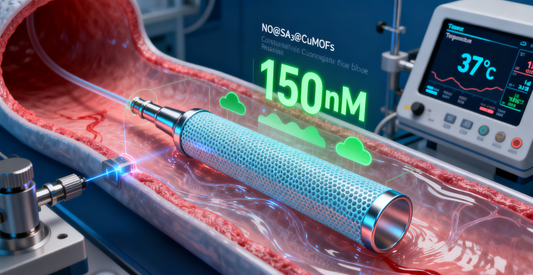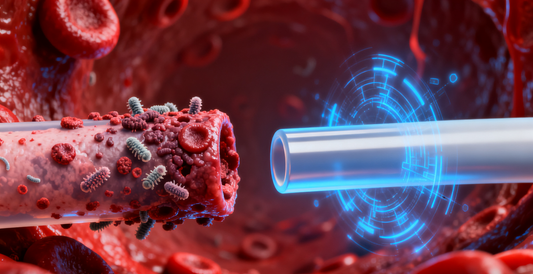
Bioinspired Zwitterionic Coating: A Breakthrough for Anti-Inflammatory and Antithrombotic Catheters
Blood-contacting catheters—such as those used in hemodialysis, extracorporeal circulation, and life-support systems—have become indispensable tools in modern clinical practice. However, they face two persistent challenges: inflammation and thrombosis. These complications not only shorten catheter lifespan but can also lead to severe clinical risks.
A research team led by Yuqi Liu, Fanjun Zhang, and Li Yang from Sichuan University recently published an important study in Macromolecular Bioscience (impact factor 5). By mimicking the outer membrane structure of red blood cells, they developed a uniform and robust bioinspired zwitterionic coating on polyvinyl chloride (PVC) catheters. This coating significantly improved anti-inflammatory and antithrombotic performance, offering a promising new approach for blood-contacting devices.
🔴 Why Is This Coating Needed?
-
Inflammation risk: Plasma protein adsorption (e.g., fibrinogen) on catheter surfaces activates leukocytes, triggering inflammation, tissue damage, and fibrosis.
-
Thrombosis risk: The same protein adsorption process also promotes platelet adhesion and activation, leading to thrombosis that can block catheters.
-
Limitations of current therapies: Anticoagulant and anti-inflammatory drugs help reduce risk, but they also increase the chance of severe side effects such as bleeding.
Thus, a surface modification strategy that provides built-in protection is highly desirable.
🧬 Innovative Design: A Red Blood Cell-Inspired Zwitterionic Coating
The team used poly(2-methacryloyloxyethyl phosphorylcholine-co-dopamine methacrylamide) (pMPCDA) copolymers to create the coating, with three key innovations:
-
Bioinspired zwitterionic structure
-
Derived from phosphatidylcholine groups in red blood cell membranes.
-
Forms a stable hydration layer with water molecules, preventing nonspecific adhesion of proteins, bacteria, and platelets.
-
-
Mussel-inspired surface chemistry
-
Polydopamine (PDA) and polyethyleneimine (PEI) were first co-deposited to create an amino-functionalized base layer.
-
Catechol and amino groups then formed multiple covalent and noncovalent bonds, ensuring the coating’s uniformity and robustness.
-
-
Adaptability to complex geometries
-
This approach successfully coats both inner and outer surfaces of cylindrical devices such as catheters, overcoming a key challenge of traditional methods.
-
🔍 Key Experimental Results
-
Antifouling and Antibacterial
-
Reduced adhesion of E. coli and S. aureus by over 99%.
-
Prevented biofilm formation, lowering infection risk.
-
-
Anticoagulant and Hemocompatibility
-
Fibrinogen adsorption decreased from 36.5 μg/cm² on bare PVC to just 2.3 μg/cm².
-
Platelet adhesion reduced by ~10-fold, with activation levels dramatically suppressed.
-
Hemolysis ratio <1%, well within international safety standards.
-
-
Anti-Inflammatory Performance (in vivo)
-
Rat subcutaneous implantation showed far fewer inflammatory cells (macrophages and neutrophils) around coated catheters.
-
Collagen capsule thickness reduced from 54.5 μm (bare PVC) to just 20.7 μm, indicating weaker foreign-body reactions.
-
-
Antithrombotic Effect (ex vivo circulation model)
-
In rabbit arteriovenous shunt tests, bare PVC catheters were blocked by thrombi with an occlusion rate of 55.6%.
-
Coated catheters had only ≈1.6% occlusion, with thrombus weight reduced from 24.8 mg to 2.3 mg.
-
🌟 Clinical Significance
This bioinspired zwitterionic coating offers multiple advantages:
-
Durability: Mussel-inspired chemistry ensures a robust, uniform coating resistant to detachment.
-
Multifunctional protection: Simultaneously resists fouling, reduces inflammation, and prevents thrombosis.
-
Safety: Exhibits excellent blood compatibility and biocompatibility for long-term use.
For hemodialysis, extracorporeal circulation, and life-support catheters, this innovation could greatly enhance safety and extend device longevity.
✅ Conclusion
By mimicking the natural outer membrane of red blood cells and leveraging mussel-inspired surface chemistry, researchers have created a uniform, stable, anti-inflammatory, and antithrombotic zwitterionic coating for PVC catheters.
This work is not only a breakthrough in biomaterials science but also a practical step toward safer, longer-lasting blood-contacting medical devices. With further clinical translation, such coatings may serve as a “protective shield” for next-generation catheters and related devices.


